Ditapis dengan

Strategic Planning What Every Manager Must Know
- Edisi
- -
- ISBN/ISSN
- 0-02-931110-1
- Deskripsi Fisik
- -
- Judul Seri
- -
- No. Panggil
- SC TXT STR g
- Edisi
- -
- ISBN/ISSN
- 0-02-931110-1
- Deskripsi Fisik
- -
- Judul Seri
- -
- No. Panggil
- SC TXT STR g

Port Planning, Engineering and Administration
- Edisi
- -
- ISBN/ISSN
- -
- Deskripsi Fisik
- 370 p
- Judul Seri
- -
- No. Panggil
- TXT SC KAW p
- Edisi
- -
- ISBN/ISSN
- -
- Deskripsi Fisik
- 370 p
- Judul Seri
- -
- No. Panggil
- TXT SC KAW p

Volatility, unpredictability and asymmetry- An organising framework for human…
This paper aims to develop the tentative hypothesis that common effective dynamics generate asymmetry volatility and unpredictability in the business, military and humanitarian logistics sectors.
- Edisi
- Vol. 32 No. 11, 2009 pp. 1024-1037
- ISBN/ISSN
- 0140-9174
- Deskripsi Fisik
- 16 p .
- Judul Seri
- Management Research News
- No. Panggil
- ATC LO CAR v C.1
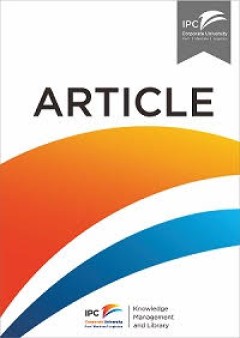
Port strategic planning: canadian port reform
- Edisi
- Vol. 28 Issue: 2, pp. 125-140
- ISBN/ISSN
- 1464-5254
- Deskripsi Fisik
- -
- Judul Seri
- Maritime Policy & Management: The flagship journal of international shipping and port research
- No. Panggil
- ATC PO IRC p
- Edisi
- Vol. 28 Issue: 2, pp. 125-140
- ISBN/ISSN
- 1464-5254
- Deskripsi Fisik
- -
- Judul Seri
- Maritime Policy & Management: The flagship journal of international shipping and port research
- No. Panggil
- ATC PO IRC p
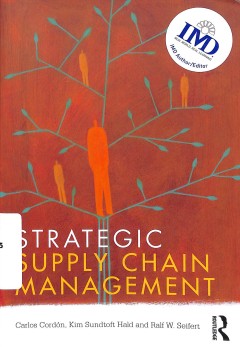
Strategic supply chain management
The supply chain is at the heart of every successful business organization's decision-making process. This textbook explains how to create a winning supply chain management strategy by spotlighting how senior executives in European and US companies have turned their supply chains into strategic weapons designed to convert threats, risks and outside pressures into competitive advantages. Strate…
- Edisi
- -
- ISBN/ISSN
- 978-0-415-59176-8
- Deskripsi Fisik
- ix, 278 p., ; 24 cm
- Judul Seri
- -
- No. Panggil
- LC 658.785 COR s
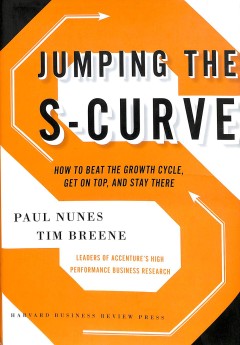
Jumping the S-Curve : how to beat the growth cycle, get on top, and stay there
Recently, some bestselling management books have focused on providing a recipe for greatness, while others have sought to unlock the secrets of long-term success. But a detailed analysis at the intersection of the two, one that explains how some companies manage to achieve repeated peaks of business performance, has been missing — until now. Accenture’s Paul Nunes and Tim Breene have found …
- Edisi
- -
- ISBN/ISSN
- 978-1-4221-7558-3
- Deskripsi Fisik
- v, 270 p., ; illus : 24 cm ; index
- Judul Seri
- -
- No. Panggil
- LC 658.4012 NUN j
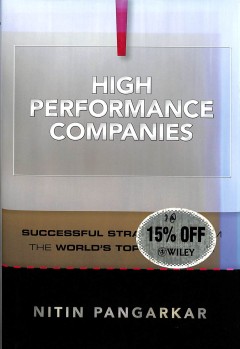
High performance companies
High Performance Companies complements the frameworks for strategy making detailed in many existing books, proposing a number of rules of thumb (or principles) that companies can consider when making their day-to-day decisions which, in turn, will determine their actual strategies. These principles traverse a wide range of scenarios, such as strategic changes implemented by companies, resource…
- Edisi
- -
- ISBN/ISSN
- 978-0-470-83010-9
- Deskripsi Fisik
- xvi, 192 p, 24 cm; index
- Judul Seri
- -
- No. Panggil
- LC 658.1 PAN h
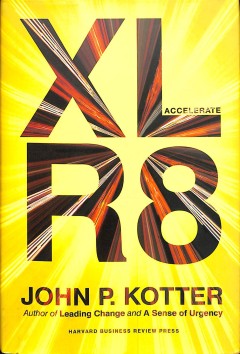
Accelerate : building strategic agility for a faster-moving world
t’s a familiar scene in organizations today: a new competitive threat or a big opportunity emerges. You quickly create a strategic initiative in response and appoint your best people to make change happen. And it does—but not fast enough. Or effectively enough. Real value gets lost and, ultimately, things drift back to the default status.Why is this scenario so frequently repeated in indust…
- Edisi
- -
- ISBN/ISSN
- 978-1-62527-174-7
- Deskripsi Fisik
- x, 206 p., ; illus : 24 cm ; index
- Judul Seri
- -
- No. Panggil
- LC 658.4012 KOT a
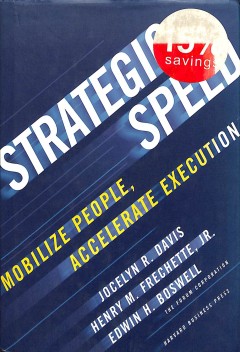
Strategic speed : mobilize people, accelerate execution
Only 30 percent of strategic initiatives are successfully executed. Of those that are, most CEOs view the process as too slow. What’s going on? And how can you accelerate execution in your company?In Strategic Speed, the authors provide the answers. Start by understanding the barriers to execution: Employees don’t grasp where an initiative is going. They don’t adopt new behaviors. They’…
- Edisi
- -
- ISBN/ISSN
- 978-1-4221-3152-7
- Deskripsi Fisik
- xii, 204 p, 22 cm; index
- Judul Seri
- -
- No. Panggil
- LC 658.401 DAV s

The Strategy Book
Thinking strategically is what separates managers and leaders. Learn the fundamentals about how to create winning strategy and lead your team to deliver it. From understanding what strategy can do for you, through to creating a strategy and engaging others with strategy, this book offers practical guidance and expert tips. It is peppered with punchy, memorable examples from real leaders winning…
- Edisi
- -
- ISBN/ISSN
- 978-0-273-75709-2
- Deskripsi Fisik
- xxix, 237p. ; 22cm.
- Judul Seri
- -
- No. Panggil
- TXT MG MCK t C.1
The Trainer's Balanced Scorecard : A Complete Resource for Linking Learning t…
The balanced scorecard (BSC) is increasingly the strategic business tool of choice for many organizations. One of the four components of the BSC, "learning and growth" is largely misunderstood, underutilized, and ineffectively applied. The BSC framework provides an opportunity for management and workplace learning and performance professionals to communicate through a common language, establish…
- Edisi
- -
- ISBN/ISSN
- 978-0-7879-9658-1
- Deskripsi Fisik
- xxxii, 388 p., ; illus : 26 cm
- Judul Seri
- -
- No. Panggil
- TXT MG PAN t

Information Technology as the Main Competence in the Design of the Strategic …
The creation of logistical support structures aims to help improve the performance of logistics along supply chains, a context where the Logistics Platforms have been gaining increasing prominence. A frequent difficulty in these ventures is to align strategic planning with the flow of cargo and the ability of the adjacent port areas. Aiming to contribute to the understanding of the importance o…
- Edisi
- 2013, Volume 8, Issue 3
- ISBN/ISSN
- 0718-2724
- Deskripsi Fisik
- 13 p.
- Judul Seri
- Journal of Technology Management and Innovation
- No. Panggil
- ATC LO VAR i
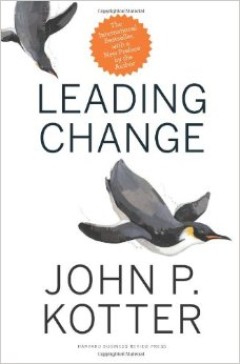
Leading Change
Millions worldwide have read and embraced John Kotter’s ideas on change management and leadership. From the ill-fated dot-com bubble to unprecedented M&A activity to scandal, greed, and ultimately, recession—we’ve learned that widespread and difficult change is no longer the exception. It’s the rule. Now with a new preface, this refreshed edition of the global bestseller Leading Change…
- Edisi
- -
- ISBN/ISSN
- 0-87584-747-1
- Deskripsi Fisik
- ix, 187 p
- Judul Seri
- -
- No. Panggil
- TXT LE KOT l

Outsourcing of integrated logistics functions- An examination of industry pra…
A survey of 372 logistics managers in different industries revealed multiple outsourcing linkages among logistics activities. These results are consistent with previous findings that suggest that firms can improve customer service and reduce costs by outsourcing multiple logistics functions. The results are also consistent with previous research on the role that improved coordination of informa…
- Edisi
- Vol. 29 Issue: 6
- ISBN/ISSN
- -
- Deskripsi Fisik
- 25 p .
- Judul Seri
- International Journal of Physical Distribution & Logistics Management
- No. Panggil
- ATC LO DRE o

Re-engineering global supply chains: Alliances between manufacturing firms an…
During the 1990s, globalization and time‐based competition have emerged as important business strategies leading to renewed emphasis on the logistics function. This has opened up opportunities for strategic alliances between manufacturing firms and specialized logistics services providers, with each partner focusing on its core area of competence. Although such alliances are common in North A…
- Edisi
- Vol. 30 Issue: 1, pp.13-34
- ISBN/ISSN
- -
- Deskripsi Fisik
- 27 p.
- Judul Seri
- International Journal of Physical Distribution & Logistics Management
- No. Panggil
- ATC LO VIS r

Volatility, unpredictability and asymmetry An organising framework for humani…
This paper aims to develop the tentative hypothesis that common effective dynamics generate asymmetry volatility and unpredictability in the business, military and humanitarian logistics sectors.
- Edisi
- Vol. 32 No. 11, 2009
- ISBN/ISSN
- -
- Deskripsi Fisik
- 16 p .
- Judul Seri
- Management Research News
- No. Panggil
- ATC LO NEU v

Applying a strategic planning process to several supply chain partners
The ability of a team from a manufacturer and its partners to formulate strategic plans for supply chains is investigated. The research aims to improve the process of formulate strategic plans for supply chains is investigated. The research aims to improve the process of formulation using the strategic operations and logistics planning (SOLP) process.
- Edisi
- Vol. 16 Iss 8 pp. 890 - 908
- ISBN/ISSN
- -
- Deskripsi Fisik
- 21 p.
- Judul Seri
- Journal of Manufacturing Technology Management
- No. Panggil
- ATC LO GUO a

A guide to the project management
The Project Management Institute, Inc. (PMI) standards and guideline publications, of which the document contained herein is one, are developed through a voluntary consensus standards development process. This process brings together volunteers and/or seeks out the views of persons who have an interest in the topic covered by this publication. While PMI administers the process and establishes…
- Edisi
- -
- ISBN/ISSN
- -
- Deskripsi Fisik
- 616 p.
- Judul Seri
- Project Management Institute
- No. Panggil
- ATC MG DIE a

Theory development in humanitarian logistics: a framework and three cases
There is a need for theory development within the field of humanitarian logistics to understand logistics needs in different stages of a crisis and how to meet these. This paper aims to discuss three dimensions identified in logistics and organization theories and how they relate to three different cases of humanitarian logistics operations – the regional concept of the International Federati…
- Edisi
- Vol. 32 No. 11, 2009 pp. 1008-1023
- ISBN/ISSN
- -
- Deskripsi Fisik
- 19 p.
- Judul Seri
- Management Research News
- No. Panggil
- ATC LO JAH t

Getting logistics into the boardroom
Ponders the factors which make senior management support of logistical initiatives so important and explores means of ensuring that such initiatives are included in the boardroom agenda. Presents an understanding of logistical activity which emphasizes its all‐embracing organizational influence, and its function as the deliverer of the marketers’ “promises”. Offers a further reason for …
- Edisi
- Vol. 9 Issue: 6, pp.11-14
- ISBN/ISSN
- -
- Deskripsi Fisik
- 5 p.
- Judul Seri
- Logistics Information Management
- No. Panggil
- ATC LO DAY g

Formal versus informal contracts: achieving alliance success
Observes that strategic alliances continue to be an important research and business focus. Many firms struggle with how to link alliance theory with actual practice. In particular, managers question how long‐term commitment between alliance partners is developed and achieved. Traditional business practice has relied primarily on formal written contracts, but informal social contracts or ver…
- Edisi
- Vol. 26 Issue: 3, pp.47-63
- ISBN/ISSN
- -
- Deskripsi Fisik
- 20 p.
- Judul Seri
- International Journal of Physical Distribution & Logistics
- No. Panggil
- ATC LO FRA f

European logistics alliances: a management model
European business environment is experiencing major changes. The process of integration in Europe, the GATT agreements, the developments in Eastern Europe, and above all, global competition are pushing European businesses to become more competitive. One area that is receiving increasing attention of managers is logistics. The gradual deregulation of the transport marketplace and the lifting of …
- Edisi
- Vol. 7 Issue: 1, pp.93-108
- ISBN/ISSN
- -
- Deskripsi Fisik
- 19 p.
- Judul Seri
- The International Journal of Logistics Management
- No. Panggil
- ATC LO VIR e

A model for strategic repositioning of service processes
The restructuring of service channels, driven by deregulation, intensifying global competition and emerging information technology, is forcing every company to re‐evaluate the adequacy of current customer services. Introduces a normative model, called service process analysis (SPA), that properly differentiates the concept of service from the specification of the delivery channel so as to fac…
- Edisi
- Vol. 6 No. 4, 1995, pp. 57-80.
- ISBN/ISSN
- -
- Deskripsi Fisik
- 28 p .
- Judul Seri
- International Journal of Service Industry Management
- No. Panggil
- ATC LO VES a

Organization for logistics- the contingency approach
Argues that the organization for logistics often favours an aggregation of all tasks into one department. This decision presupposes an extensive analysis of important contingency factors, like product line, environmental relations, technology and organizational size. However, such contingency factors have a limited influence, and are modified by the strategy of the organization. Defines selec…
- Edisi
- Vol. 27 Issue: 5/6
- ISBN/ISSN
- -
- Deskripsi Fisik
- 17 p.
- Judul Seri
- International Journal of Physical Distribution & Logistics Management
- No. Panggil
- ATC LO CHR o

Strategic supplier partnering: a psychological contract perspective
Strategic supplier partnering (SSP) represents an increasingly popular way for buyers and sellers to do business. Defined as a co-operative and collaborative way in which buying and supplying firms interact to achieve mutually beneficial outcomes, these relationships position participants to be more competitive in the marketplace. This concept has become increasingly popular in purchasing and l…
- Edisi
- Vol. 27 No. 9/10, 1997
- ISBN/ISSN
- -
- Deskripsi Fisik
- 17 p.
- Judul Seri
- International Journal of Physical Distribution & Logistics Management
- No. Panggil
- ATC LO BLA s

A conceptual framework for assessing strategic packaging decisions
Over the past decade, increased logistics costs, improved packaging technology, and enhanced environmental regulations have caused logistics managers to reevaluate their packaging decisions. The impact of packaging decisions on logistics costs illustrates the need for strategic thinking in the assessment of packaging options. In addition, the combination of more demanding technological and envi…
- Edisi
- Vol. 6 Iss 1 pp. 51 - 60
- ISBN/ISSN
- -
- Deskripsi Fisik
- 12 p.
- Judul Seri
- The International Journal of Logistics Management
- No. Panggil
- ATC LO LOC a

Strategic planning in smaller enterprises – new empirical findings
To analyze the performance implications of essential elements of strategic planning (time span, formalization, frequency of control, and use of planning instruments) in smaller enterprises in a simultaneous way.
- Edisi
- Vol. 29 No. 6, 2006
- ISBN/ISSN
- -
- Deskripsi Fisik
- 14 p.
- Judul Seri
- Management Research News
- No. Panggil
- ATC LO ERI s
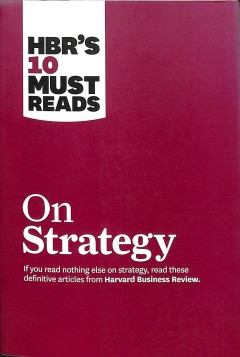
Hbr's 10 must reads : on strategy
Is your company spending enormous time and energy on strategy development, with little to show for your efforts? We've combed through hundreds of Harvard Business Review articles on strategy and selected the most important ones to help galvanize your organization's strategy development and execution. This collection includes: featured article "What Is Strategy?" by Michael E. Porter, "The Five …
- Edisi
- -
- ISBN/ISSN
- 978-1-4221-5798-5
- Deskripsi Fisik
- v, 266 p, 21 cm ; index
- Judul Seri
- -
- No. Panggil
- LC 658.401 REV h

Strategic Thinking : a Nine Step Approach to Strategy and Leadership for Mana…
Now in its third edition, Strategic Thinking, takes you step by step through the questions to ask, in order to formulate strategies and write clear and concise strategic plans. Based on three core actions - creating knowledge, innovating ideas and implementing change - Strategic Thinking consists of hundreds of examples and advice on: how to gain a deeper underst…
- Edisi
- 3rd ed.
- ISBN/ISSN
- 978-0-7494-6077-8
- Deskripsi Fisik
- ix, 150p. ; 24cm.
- Judul Seri
- -
- No. Panggil
- MG WOO s
 Karya Umum
Karya Umum  Filsafat
Filsafat  Agama
Agama  Ilmu-ilmu Sosial
Ilmu-ilmu Sosial  Bahasa
Bahasa  Ilmu-ilmu Murni
Ilmu-ilmu Murni  Ilmu-ilmu Terapan
Ilmu-ilmu Terapan  Kesenian, Hiburan, dan Olahraga
Kesenian, Hiburan, dan Olahraga  Kesusastraan
Kesusastraan  Geografi dan Sejarah
Geografi dan Sejarah